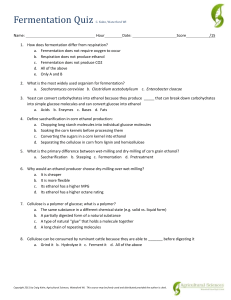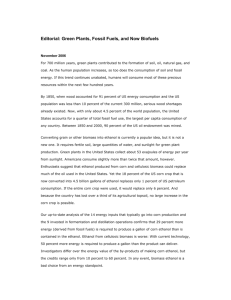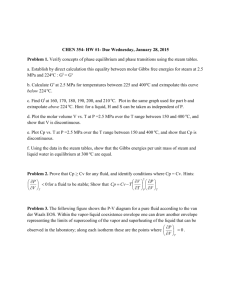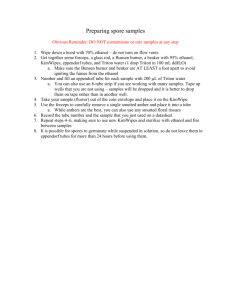Notesheet
advertisement
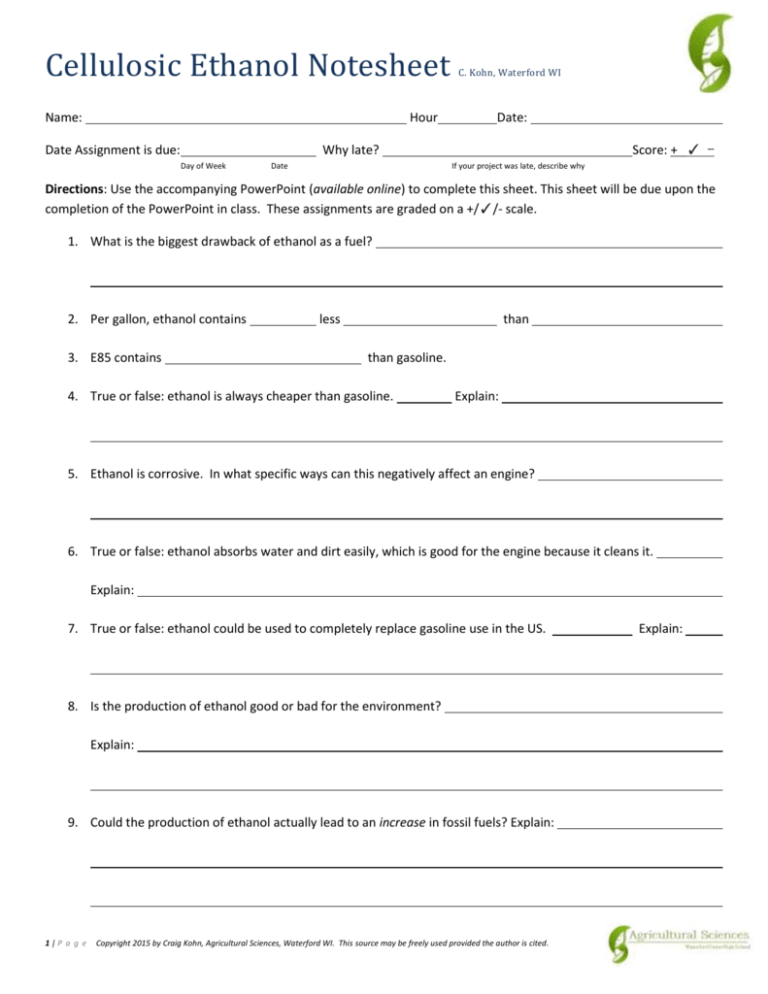
Cellulosic Ethanol Notesheet Name: Hour Date Assignment is due: C. Kohn, Waterford WI Date: Score: + ✓ - Why late? Day of Week Date If your project was late, describe why Directions: Use the accompanying PowerPoint (available online) to complete this sheet. This sheet will be due upon the completion of the PowerPoint in class. These assignments are graded on a +/✓/- scale. 1. What is the biggest drawback of ethanol as a fuel? 2. Per gallon, ethanol contains 3. E85 contains less than than gasoline. 4. True or false: ethanol is always cheaper than gasoline. Explain: 5. Ethanol is corrosive. In what specific ways can this negatively affect an engine? 6. True or false: ethanol absorbs water and dirt easily, which is good for the engine because it cleans it. Explain: 7. True or false: ethanol could be used to completely replace gasoline use in the US. 8. Is the production of ethanol good or bad for the environment? Explain: 9. Could the production of ethanol actually lead to an increase in fossil fuels? Explain: 1|P a g e Copyright 2015 by Craig Kohn, Agricultural Sciences, Waterford WI. This source may be freely used provided the author is cited. Explain: 10. How much corn was used for ethanol in 2000? How much was used in 2013? 11. True or false: because corn for ethanol can be made into DDGs, it doesn’t compete with food availability Explain: 12. How much of the world’s corn does the US product? How does this affect the ethanol debate? 13. What are three reasons for why there is still interest in ethanol despite these problems? 1 2 3 14. True or false: corn is the only viable option we have in the US for producing ethanol. 15. True or false: cellulose is a potential source of fuel that is very abundant. Explain: Explain: 16. What percent of US gasoline could be displaced if agricultural waste (such as grass, wood chips, and fodder) were made into ethanol? Could existing infrastructure and businesses be used for this? 17. What are 9 benefits of cellulosic ethanol over corn ethanol? (continues on the next page) 1 2 3 4 2|P a g e Copyright 2015 by Craig Kohn, Agricultural Sciences, Waterford WI. This source may be freely used provided the author is cited. 5 6 7 8 9 18. So if there are so many benefits associated with cellulosic ethanol in comparison to corn ethanol, why is the vast majority of ethanol in the US made from corn? Include the following in your response: a) polymer; b) cellulose; c) hemicellulose; d) lignin 19. A polymer is a long, of a 20. Cellulose is a polymer that consists of a long, repeating chain of 21. Why would plants need their cellulose to be so resistant to degradation? 22. Use the spaces below to describe the function played by each type of molecule found in plant cell walls: Hemicellulose: Lignin: 23. Draw the cellulose, lignin, and hemicellulose as they would be found in a plant cell wall in the space below: 3|P a g e Copyright 2015 by Craig Kohn, Agricultural Sciences, Waterford WI. This source may be freely used provided the author is cited. 24. True or false: cellulose is similar to starch in that it is just a chain of glucose molecules. 25. If cellulose is just a chain of glucose like starch, why is it that we can easily break down starch but not ethanol? List two reasons; one entails bond orientations, and the other entails lignin and hemicellulose. 26. Define pretreatment: 27. Define hydrolysis: 28. Which step is the ‘unraveling’ step? 29. Which step is the ‘unpacking’ step? 30. True or false: if we could make pretreatment and hydrolysis more effective, we could likely make plentiful, affordable supplies of cellulosic ethanol and displace large amounts of fossil fuels. 31. To be economically viable, the production cost per gallon of cellulosic ethanol has to be $ Explain: or less. 32. Why do we even think this is feasible? What example exists that indicates that large amounts of a high energy fluid can be produced from cellulosic sources in a profitable, affordable manner? 33. Summarize the five steps in which a cow produces milk from cellulosic sources: 4|P a g e Copyright 2015 by Craig Kohn, Agricultural Sciences, Waterford WI. This source may be freely used provided the author is cited. 34. Summarize the six steps in which cellulosic ethanol can be produced: 35. Draw the steps of cellulosic ethanol below (see the slide after the six steps). 36. Why is it that cows already have the microbes they need to obtain energy from cellulose by scientists do not? 37. If cellulosic ethanol has so many obstacles associated with pretreatment and hydrolysis, why is there so much interest? 38. Take a stance on cellulosic ethanol – is this a viable option to replace fossil fuels or an unlikely pipe dream? 5|P a g e Copyright 2015 by Craig Kohn, Agricultural Sciences, Waterford WI. This source may be freely used provided the author is cited. Unit Wrap-up C. Kohn, Agricultural Sciences - Waterford WI This page is designed to help raise your grade while enabling you to develop skills you will need for after high school. You will need to complete every question and blank in order to receive full credit for your notes. Note: if you cannot come up with a strategy to remember a difficult concept on your own, see your instructor for help. 1. What is a topic or concept from this unit that you found to be more challenging? Write or describe below: In the space below, create a mnemonic, rhyme, analogy, or other strategy to help you remember this particular concept: 2. What is a 2nd topic or concept from this unit that you found to be more challenging? Write or describe below: In the space below, create a mnemonic, rhyme, analogy, or other strategy to help you remember this particular concept: 3. What is a 3rd topic or concept from this unit that you found to be more challenging? Write or describe below: In the space below, create a mnemonic, rhyme, analogy, or other strategy to help you remember this particular concept: 4. Circle the most appropriate response. You will only be graded on whether or not you completed this section. Circle one: I used my notes outside of class to prepare for the quiz. Definitely – Yes – Sort of - No Circle one: I took extra notes in the margins for very difficult concepts. Definitely – Yes – Sort of - No Circle one: I created a personal strategy for at least three difficult items. Definitely – Yes – Sort of - No Circle one: I was very involved and actively studying during the quiz review. Definitely – Yes – Sort of - No Circle one: I think I will be satisfied with the quiz grade I received this week. Definitely – Yes – Sort of - No Circle one: I might need to meet with the instructor outside of class. 6|P a g e Definitely – Yes – Sort of - No Copyright 2015 by Craig Kohn, Agricultural Sciences, Waterford WI. This source may be freely used provided the author is cited.

